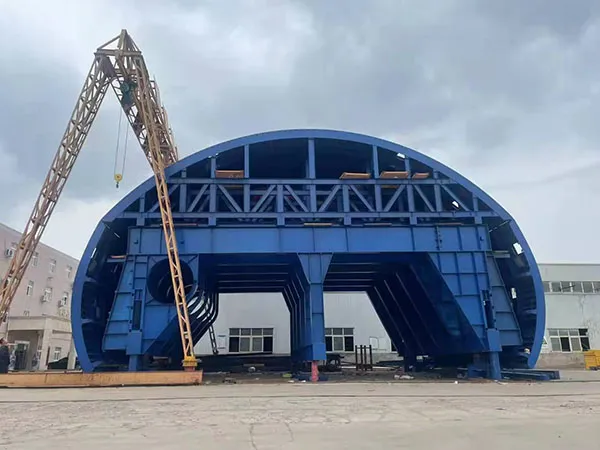Tunnel lining trolleys, also known as tunnel formwork systems or tunnel shuttering machines, are essential equipment used for in-situ concrete lining in tunnel construction. Depending on tunnel structure, size, and construction methods, tunnel lining trolleys can be classified into several types. These are large, mobile structures used inside tunnels to support the formwork for cast-in-place concrete linings or to install precast concrete segments.

The primary categorization is based on the type of lining they are designed for:
These trolleys carry large sections of steel formwork. They position the formwork against the excavated tunnel profile, concrete is pumped behind it, and once the concrete cures sufficiently, the trolley lowers (strips) the formwork and moves forward (travels) to the next section.
Sub-types based on Formwork Configuration:
Full-Round Formwork Trolley: Carries formwork for the entire tunnel cross-section (invert, walls, and arch) allowing for a single pour. Complex and heavy, often used for circular or near-circular tunnels.
Arch (or Crown/Sidewall) Formwork Trolley: Carries formwork only for the upper arch and sidewall sections. This is used when the invert (floor) is cast separately first (often using simpler screeding or a dedicated invert form). This is very common for horseshoe or D-shaped tunnels.
Invert Formwork Trolley: Specifically designed to carry the formwork for casting the tunnel floor (invert). Often used in conjunction with an Arch Formwork Trolley.
Telescopic Formwork Trolley: The formwork sections are designed to retract inwards (like a telescope) after stripping. This allows the entire trolley to move forward through the previously cast lining section without needing extensive dismantling. This is the most common type for longer tunnels due to efficiency.
Non-Telescopic (Collapsible) Formwork Trolley: Sections may hinge or collapse, but might not fully telescope. Movement might require more clearance or partial dismantling. Less common for continuous tunnel drives.
Portal Formwork: While not strictly a "trolley" in the travelling sense, specialized formwork systems are used at the tunnel entrances/exits (portals).

These are used primarily in tunnels excavated by Tunnel Boring Machines (TBMs), although variations exist for conventional tunnels installing precast linings.
Their main function is to pick up precast concrete segments (delivered usually by multi-service vehicles or segment cars), rotate them to the correct orientation, and precisely place them to form a complete ring against the TBM's shield or the previously installed ring.
Sub-types/Variations:
TBM Integrated Erectors: Most common. The erector mechanism is built directly into the TBM's backup system, immediately behind the cutterhead shield. It's technically part of the TBM system rather than a separate "trolley" in the same sense as a formwork traveller, but performs the lining function. They often use vacuum lifters or mechanical grippers.
Standalone Segment Trolleys/Gantries: In some conventional tunnels (NATM/Drill & Blast) or for secondary linings/special structures (like station caverns), separate, mobile gantries or trolleys might be used to transport and erect precast segments. These are less common than TBM integrated systems for main tunnel drives.
Other Ways to Categorize (Factors influencing design):
Propulsion System: How the trolley moves (hydraulic rams pushing off the lining/rails, electric motors driving wheels, winches).
Support System: How it's supported (rails on the invert, wheels directly on the invert, side-wall supports).
Hydraulic vs. Mechanical Operation: Systems for lifting, positioning, and stripping the formwork or segments. Most modern systems rely heavily on hydraulics.
Tunnel Shape: Designs are specific to circular, horseshoe, rectangular, or other custom tunnel shapes.
Automation Level: Ranging from manual controls to semi-automated or fully automated systems.
In summary, the main distinction is between formwork trolleys used for pouring concrete in place and segment erectors used for placing precast segments, with further variations based on the specific configuration and method of operation. The exact design is almost always custom-engineered for the specific tunnel project's requirements (geometry, length, geology, construction method).
Gaofei
Address: 200m east of tulip garden, group 12 of zhangling community, hongshan street office, hongshan town, xigong district, Luoyang
Tel: +8616638856888
Contact: Gaofei Huang
Mobile: +86-18637923976
Phone: 0379-80881719/ 0379-60162687
QQ: 286827457
E-mail: gaofei@gf-bridge-tunnel.com